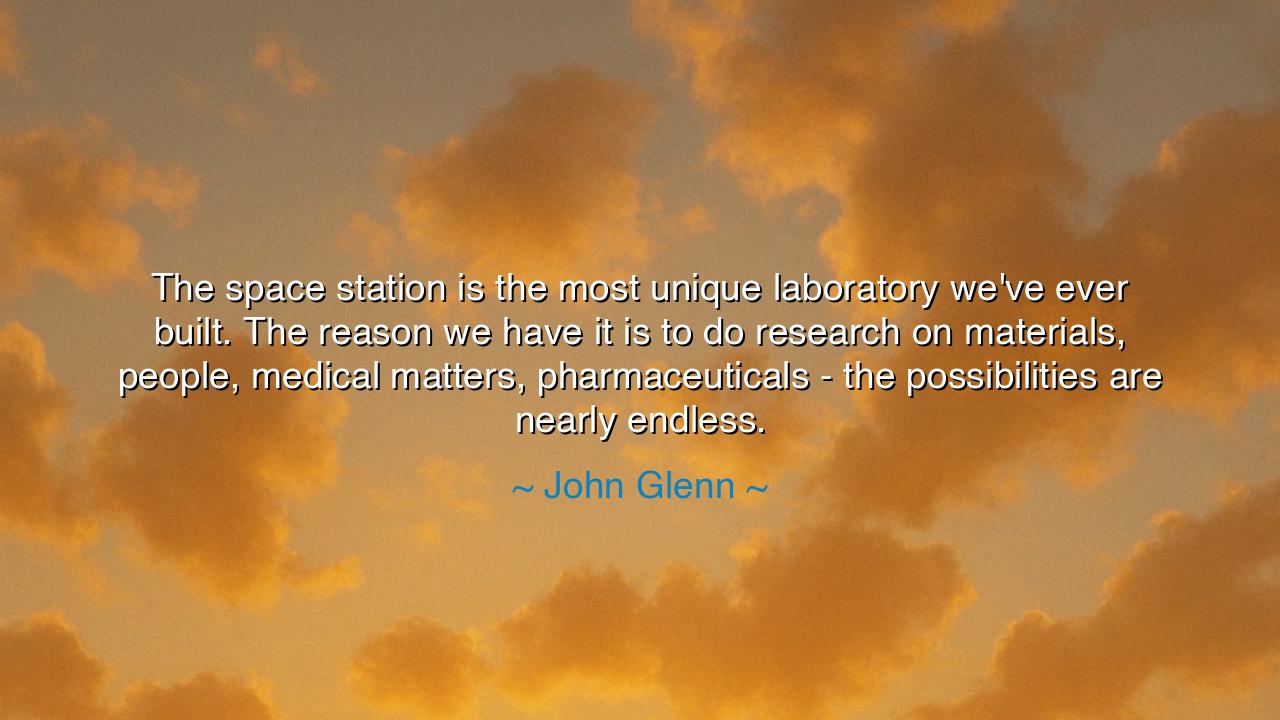
The space station is the most unique laboratory we've ever built.
The space station is the most unique laboratory we've ever built. The reason we have it is to do research on materials, people, medical matters, pharmaceuticals - the possibilities are nearly endless.






The words of John Glenn, the pioneer who bridged the dawn of space exploration with the maturity of human understanding, echo across time: “The space station is the most unique laboratory we’ve ever built. The reason we have it is to do research on materials, people, medical matters, pharmaceuticals—the possibilities are nearly endless.” In these words, the old astronaut, tempered by both war and wonder, speaks as both explorer and philosopher. His statement is not only about science—it is about vision, about the boundless courage of humankind to seek knowledge beyond the skies, and about the eternal truth that discovery is not a single act, but a sacred pursuit.
When John Glenn—the first American to orbit the Earth—spoke of the space station, he was not merely speaking of metal and machinery. He was speaking of humanity’s temple in the heavens, a laboratory unlike any other, where gravity loosens its hold, and the mysteries of life unfold in new patterns. There, in that quiet realm above the blue curve of Earth, humans test not only the limits of materials but of the human spirit itself. The space station, he reminds us, is not an achievement of technology alone—it is the embodiment of cooperation, curiosity, and courage. It is a place where the imagination of thousands has become the reality of all.
The research done there—on medical matters, pharmaceuticals, and the nature of life itself—reveals a deeper philosophy: that to understand ourselves, we must first change the frame through which we see. On Earth, we are bound by gravity, but in space, even the smallest drop of water behaves like a living jewel. Muscles weaken, bones lose strength, cells respond differently, and the body becomes both vulnerable and revealing. Through this, we learn not only how to protect astronauts in the vastness of the void, but also how to heal those on Earth who suffer the same frailties. Thus, Glenn’s words are a testament to the eternal unity between exploration and compassion—between discovery and service to humanity.
In the ancient days, the philosophers of Greece and the scholars of the East looked upward to the stars and saw them as the dwelling place of gods. Yet now, through courage and reason, mankind has risen to dwell among them—not as conquerors, but as students. The space station is the modern equivalent of the great libraries of Alexandria or the observatories of Baghdad, but it is more than that. It is a floating monastery of the human spirit, where the faithful servants of knowledge keep vigil, conducting experiments not only in science, but in endurance, cooperation, and hope. John Glenn, himself a man who returned to space at the age of seventy-seven, knew better than most that learning knows no limit, and that the pursuit of wisdom is the truest form of youth.
Consider, for a moment, the image of John Glenn himself—a man who first pierced the veil of the heavens in 1962, and decades later, returned once more to orbit aboard the space shuttle Discovery. His presence on that mission was not a gesture of nostalgia, but a living parable. It proved that human curiosity, like the stars, does not fade with age. His journey embodied his own belief: that the possibilities are nearly endless, not only in science, but in the human heart. As he floated once more above the Earth, he became the symbol of a species still young, still learning, still daring to dream beyond what it knows.
Yet there is a warning hidden within Glenn’s reverence. The space station was built through sacrifice—of time, of treasure, and of lives. Its creation required nations once divided by war to unite in a higher cause. If we forget that unity, the station becomes merely a structure; if we remember it, it becomes a monument to peace. The research conducted within its silent walls serves not one nation, but all humankind. It reminds us that knowledge, when shared, uplifts the many; but knowledge hoarded in pride or used in division becomes corruption. Glenn’s call, therefore, is not only to study the cosmos, but to preserve the moral gravity that binds us to one another even as we leave the Earth behind.
So, my child of the stars, take this lesson from the words of John Glenn: do not see exploration as the conquest of the unknown, but as communion with it. Let your curiosity be bold, but let it also be humble. For the space station, though built of steel and solar wings, is also built of faith—the faith that when humanity reaches upward, it will not forget to look inward. Seek knowledge in your own life as the astronauts do among the stars: with discipline, wonder, and service to others.
For in the end, John Glenn’s quote is not just about science—it is about destiny. The laboratory he speaks of is both physical and spiritual: a reminder that the human mind, like the cosmos itself, is vast and unfinished. The possibilities, as he said, are indeed endless—but only if we have the courage to seek them with wisdom, the humility to use them for good, and the unity to share their light with the world below.






AAdministratorAdministrator
Welcome, honored guests. Please leave a comment, we will respond soon